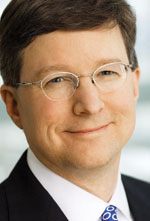
After more than 40 years of operation, DTVE is closing its doors and our website will no longer be updated daily. Thank you for all of your support.
Age of Discovery
 Discovery plans more international launches to follow that of TLC in the Nordic territories. Stuart Thomson talked to Discovery International president and CEO Mark Hollinger.
Discovery plans more international launches to follow that of TLC in the Nordic territories. Stuart Thomson talked to Discovery International president and CEO Mark Hollinger.
Discovery Communications International is planning further international launches, following the March 4 debut of female lifestyle-oriented channel TLC in Norway on the Canal Digital, GET and Lyse networks. Discovery aims to take the channel to other territories over the next 18 months, with the goal to take it into 100 million homes internationally.
Speaking to Digital TV Europe ahead of his keynote speech at February’s Cable Congress, Discovery International president and CEO Mark Hollinger said that the launch of TLC internationally met a need on the part of Discovery for a more balanced international portfolio that has hitherto relied primarily on affiliate revenues rather than advertising sales.
“We are still oriented towards affiliate revenue in our international portfolio, so we thought ad revenue was an area to go for,” said Hollinger. “Except for Discovery Kids in Latin America we have not had a strong ad sales story in the international portfolio and the mission was to find that.” Hollinger said that the launch of a female-oriented channel also gave balance to a portfolio that hitherto has been predominantly male-oriented. The launch of TLC also built on the success of the channel in the US over the last two years, which has been accompanied by the creation of a strong programme production base to support it.
Hollinger said that TLC could be followed by other international services, possibly including the Oprah Winfrey Network (OWN) and The Hub, the re-branded kids channel that Discovery is launching in a joint venture with toy maker Hasbro in the US this autumn. The aim, he said, was to have three or four strong ad-supported channels in international markets. “OWN has the potential to be a strong brand in some markets,” he said. “Whether it has broader distribution elsewhere remains to be seen,” he said. In general, Discovery will look to how well a channel is received in the US before launching it internationally.
“We are still oriented towards affiliate revenue in our international portfolio, so we thought ad revenue was an area to go for.”
Mark Hollinger, Discovery Networks International
Hollinger said Discovery also had “some international ambitions” for the Hasbro joint venture. “Plans are undefined at this point,” he said. The existing Discovery Kids channel is strong in Latin America, where Discovery stole a march on its competitors, but lack of investment in programming has acted as a brake on its development in the US and elsewhere. “Now with enhanced production investment along with Hasbro, maybe we can add a second channel in Latin America and take a kids channel to other markets,” he said.
TLC will be locally versioned for each market. “It’s intended to be a global channel but the strategy will differ in terms of the programming mix, which will be more localised and customised for TLC than it is for the Discovery Channel,” said Hollinger, who added that this was made necessary by the lifestyle-oriented element of the channel’s remit. He said investment in local programming was “a substantial priority”. Discovery will also draw on its programming base for other channels to bolster TLC’s output, including using content from Discovery ID. “In markets where ID doesn’t have distribution we could draw on that rather than launch in parallel,” said Hollinger.
Long view
In the face of something of a sustained global crisis in the advertising market, Hollinger is keen to point out that the broadcaster takes a long view. “Our shareholders are long-term investors – they’re not going to take decisions based on the next quarter,” he said. “The other thing that’s been interesting is that we saw in the US that having a diverse portfolio was a benefit in a downturn.”
Discovery’s keenness to derive a greater portion of revenue from advertising also testifies to pressure on affiliate revenues, a point that Hollinger addressed in his keynote address, where he spoke of the critical nature of the dual revenue stream from advertising and carriage fees to pay-TV channels, and highlighted problems in the US, where demands by Fox for what he called a “disproportionate share of licence fees” from Time Warner Cable has raised a threat to independent programmers including Discovery. “Collaboration and partnerships between programmers and distributors is more important than ever, but we are seeing much more of a breakdown in that relationship,” he told Digital TV Europe. “Our position is to create a great product that will drive distribution and audiences for pay-TV. In exchange for that we should get our fair share of licence fees and shelf space. That’s what launching TLC is all about. I think relationships with affiliates are tough in a lot of places, but we continue to believe it’s more about partnerships than exercising leverage and we hope that will take us where we want to go.”
Further ahead, Discovery is looking to deliver additional value to pay-TV distribution partners by investing in 3D, despite what Hollinger called the “uncertain business model”. The company is currently working on 3D in the US in partnership with Sony and Imax. Hollinger told Cable Congress that Discovery had received strong interest in 3D content and 3D networks from international distributors.


